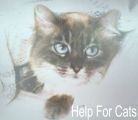New update on Grey Bear
New update on Grey Bear
She's at home now with her feeding tube in. She's doing pretty good. We got food into her, she threw it up but we expected that. She's also on Clindamycin. WE don't have the results of the biopsy yet, but hopefully soon. There was some spotting on the liver which was believed to be cirhossis (sp?) Surprisingly, her liver enzymes were very close to being normal again, so there's quite a bit of hope. We also took a swab of the liver cells so that it can be cultured to check for bacteria and such. Thanks everyone for your support and encouraging me to find a new vet.
Erica,
You must be VERY careful when feeding her through her tube. You must first use a couple cc's of water first, then the food, then end the feeding with 2 more cc's of water. The water given first flushes the tube so that it makes for easier passage of the food and doesn't clog the tube; it also serves as dehydration support. Water given after the feeding fits the same purpose. Also, make absolutely certain that your vet has instructed you properly on mixing the food with water, the correct amount to feed at each feeding session, and that you use the syringe SLOWLY. Do not push the food through the tube too fast, because this WILL cause vomiting. The tube bypasses the mouth, allowing food to go directly into the stomach, so when food is forced, it must be given slowly. It should take about a full minute or two to get the food from the syringe through the tube. Example, if your vet instructed you to give 40 cc's of food per meal, it should take you approximately 2-5 minutes to feed through the tube.
Do NOT skip a feeding, as per your vet's instructions. Feeding tube patients must be on a strict schedule (amount per meal, and number of meals per day) and you must comply with the schedule explicitly. If at any time she vomits during a meal, stop immediately, and let her rest for about an hour, and proceed again. If the vomiting continues, you must call your vet immediately.
If this is a naso-esophageal tube (inserted through her nose), the feeding must go even slower because the tube can dislodge in the stomach and cause great problems; the tube is also much smaller than a parenteal tube. If vomiting occurs, cease feeding and call your vet IMMEDIATELY. If this is a parenteal tube (inserted in her side, directly into her stomach), the feeding is not as risky, yet you still have to go slow to prevent vomiting. Remember, these tubes go directly into the stomach, bypassing all chewing, swallowing, and makes for longer digestion, so you have to be careful not to feed too fast.
If your vet by chance did not give you specific instructions, call him back and demand them. It's so important that you understand this feeding shedule in order for her liver to regenerate. Cirrhosis is not a good thing and can escalate into bigger problems. Hopefully, the cirrhosis can be halted through your vet's current medical approach, but you have to keep an eagle eye on GreyBear, and notify your vet at once should anything unusual occur, no time to waste if something unusual develops.
If the tube is a parenteal tube, be sure to watch her incision area carefully for any signs of bruising, swelling, discharge of blood or pus, or if it feels hot to the touch. If any of these symptoms occur, do not wait, get her back to ER immediately. Infection can set in the incision area. While rare, it can occur, so watch that carefully.
Followup as your vet advises, and don't be afraid to call him for any questions you might have about any of her feeding, treatment, noticing unusual symptoms, etc. Keep her comfortable and stress free....
You must be VERY careful when feeding her through her tube. You must first use a couple cc's of water first, then the food, then end the feeding with 2 more cc's of water. The water given first flushes the tube so that it makes for easier passage of the food and doesn't clog the tube; it also serves as dehydration support. Water given after the feeding fits the same purpose. Also, make absolutely certain that your vet has instructed you properly on mixing the food with water, the correct amount to feed at each feeding session, and that you use the syringe SLOWLY. Do not push the food through the tube too fast, because this WILL cause vomiting. The tube bypasses the mouth, allowing food to go directly into the stomach, so when food is forced, it must be given slowly. It should take about a full minute or two to get the food from the syringe through the tube. Example, if your vet instructed you to give 40 cc's of food per meal, it should take you approximately 2-5 minutes to feed through the tube.
Do NOT skip a feeding, as per your vet's instructions. Feeding tube patients must be on a strict schedule (amount per meal, and number of meals per day) and you must comply with the schedule explicitly. If at any time she vomits during a meal, stop immediately, and let her rest for about an hour, and proceed again. If the vomiting continues, you must call your vet immediately.
If this is a naso-esophageal tube (inserted through her nose), the feeding must go even slower because the tube can dislodge in the stomach and cause great problems; the tube is also much smaller than a parenteal tube. If vomiting occurs, cease feeding and call your vet IMMEDIATELY. If this is a parenteal tube (inserted in her side, directly into her stomach), the feeding is not as risky, yet you still have to go slow to prevent vomiting. Remember, these tubes go directly into the stomach, bypassing all chewing, swallowing, and makes for longer digestion, so you have to be careful not to feed too fast.
If your vet by chance did not give you specific instructions, call him back and demand them. It's so important that you understand this feeding shedule in order for her liver to regenerate. Cirrhosis is not a good thing and can escalate into bigger problems. Hopefully, the cirrhosis can be halted through your vet's current medical approach, but you have to keep an eagle eye on GreyBear, and notify your vet at once should anything unusual occur, no time to waste if something unusual develops.
If the tube is a parenteal tube, be sure to watch her incision area carefully for any signs of bruising, swelling, discharge of blood or pus, or if it feels hot to the touch. If any of these symptoms occur, do not wait, get her back to ER immediately. Infection can set in the incision area. While rare, it can occur, so watch that carefully.
Followup as your vet advises, and don't be afraid to call him for any questions you might have about any of her feeding, treatment, noticing unusual symptoms, etc. Keep her comfortable and stress free....
..........Traci
Grey Bear
Thanks Traci. We're being super careful about feeding. We think the throwing up had to do with actually having food in her stomach and also the medication that we are using can cause stomach upset and nausea. She's on a pretty strict schedule, coming with me to work and everything so I can feed her. It has a tendency to get clogged up no matter what I do. I need to call the vet & see if that's normal. I usually have to give a little bit of food, followed by some water and then start again. I may not be diluting the food enough. I'm going to call and find out exactly howmuch to dilute.
Depending on the food your vet gave you......Ideally it should be either Hill's Rx A/D or Eukanuba Recovery Diet. Both need to be mixed to a slightly soupy consistency. Anything else will definately clog the tube. You can't risk clogging because if you forget to flush with water after the feeding, the clog will dry and make it so much harder for the next feeding. That 2 cc's of water in the beginning and end of each feeding takes care of that problem.
Antibiotics can also be given through the tube as long as they are liquid. You can draw up a little food, then the liquid meds, then draw up the remaining amount in the syringe and then feed all through the tube.
Antibiotics can also be given through the tube as long as they are liquid. You can draw up a little food, then the liquid meds, then draw up the remaining amount in the syringe and then feed all through the tube.
..........Traci
- Auntie Debbie
- The Mod Squad
- Posts: 1258
- Joined: Sun Apr 20, 2003 5:12 am
- Location: over the rainbow
- Contact:
Glad she's home
I hope the feedings will go well from now on. Hopefully your new vet will be able to get her back on her feet soon. She remains in my prayers for a full recovery....and I hope you're not too stressy too. We're all here for you both! 
Kitty kisses,
Debbie
____________________________________
"Those we shelter on earth will be our treasures in Heaven." Victor Hugo, I think
Debbie
____________________________________
"Those we shelter on earth will be our treasures in Heaven." Victor Hugo, I think

